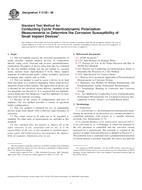Potřebujeme váš souhlas k využití jednotlivých dat, aby se vám mimo jiné mohly ukazovat informace týkající se vašich zájmů. Souhlas udělíte kliknutím na tlačítko „OK“.
ASTM F2129-08
Standard Test Method for Conducting Cyclic Potentiodynamic Polarization Measurements to Determine the Corrosion Susceptibility of Small Implant Devices
Automaticky přeložený název:
Standardní zkušební metoda pro dirigování Cyklické potenciodynamické polarizační měření určit korozi náchylnost Small implantu
NORMA vydána dne 1.10.2008
Informace o normě:
Označení normy: ASTM F2129-08
Poznámka: NEPLATNÁ
Datum vydání normy: 1.10.2008
Kód zboží: NS-52930
Počet stran: 9
Přibližná hmotnost: 27 g (0.06 liber)
Země: Americká technická norma
Kategorie: Technické normy ASTM
Anotace textu normy ASTM F2129-08 :
Keywords:
corrosion, cyclic polarization, medical device testing, pitting potential, protection potential, rest potential, Corrosion--surgical implants, Cyclic potentiodynamic polarization measurement, ICS Number Code 11.040.40 (Implants for surgery, prothetics and orthotics)
Doplňující informace
| Significance and Use | ||||||||||||||||
|
Corrosion of implantable medical devices can have deleterious effects on the device performance or may result in the release of corrosion products with harmful biological consequences; therefore, it is important to determine the general corrosion behavior as well as the susceptibility of the devices to localized corrosion. The forming and finishing steps used to create an implantable device may have significant effects on the corrosion resistance of the material out of which the device is fabricated. During the selection process of a material for use as an implantable device, testing the corrosion resistance of the material is an essential step; however, it does not necessarily provide critical data regarding device performance. To accommodate the wide variety of device shapes and sizes encountered, a variety of holding devices can be used. Note that the method is intentionally designed to reach conditions that are sufficiently severe to cause breakdown and deterioration of the medical devices and that these conditions may not be necessarily encountered in vivo. The results of this corrosion test conducted in artificial physiological electrolytes can provide useful data for comparison of different device materials, designs, or manufacturing processes. However, note that this test method does not take into account the effects of cells, proteins, and so forth on the corrosion behavior in vivo. |
||||||||||||||||
| 1. Scope | ||||||||||||||||
|
1.1 This test method assesses the corrosion susceptibility of small, metallic, implant medical devices, or components thereof, using cyclic (forward and reverse) potentiodynamic polarization. Examples of device types that may be evaluated by this test method include, but are not limited to, vascular stents, ureteral stents (Specification F 1828), filters, support segments of endovascular grafts, cardiac occluders, aneurysm or ligation clips, staples, and so forth. 1.2 This test method is used to assess a device in its final form and finish, as it would be implanted. These small devices should be tested in their entirety. The upper limit on device size is dictated by the electrical current delivery capability of the test apparatus (see Section 6). It is assumed that test methods, such as Reference Test Method G 5 and Test Method G 61 have been used for material screening. 1.3 Because of the variety of configurations and sizes of implants, this test method provides a variety of specimen holder configurations. 1.4 This test method is intended for use on implantable devices made from metals with a relatively high resistance to corrosion. 1.5 The values stated in SI units are to be regarded as standard. No other units of measurement are included in this standard. 1.6 This standard does not purport to address all of the safety concerns, if any, associated with its use. It is the responsibility of the user of this standard to establish appropriate safety and health practices and determine the applicability of regulatory limitations prior to use. ^REFERENCE: ASTM Standards: D 1193 Specification for Reagent Water E 177 Practice for Use of the Terms Precision and Bias in ASTM Test Methods E 691 Practice for Conducting an Interlaboratory Study to Determine the Precision of a Test Method F 1828 Specification for Ureteral Stents G 3 Practice for Conventions Applicable to Electrochemical Measurements in Corrosion Testing G 5 Reference Test Method for Making Potentiostatic and Potentiodynamic Anodic Polarization Measurements G 15 Terminology Relating to Corrosion and Corrosion Testing G 61 Test Method for Conducting Cyclic Potentiodynamic Polarization Measurements for Localized Corrosion Susceptibility of Iron-, Nickel-, or Cobalt-Based Alloys |
||||||||||||||||
| 2. Referenced Documents | ||||||||||||||||
|




 Cookies
Cookies
